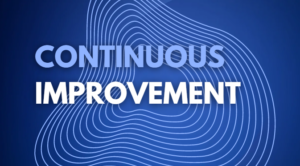
There is never a day where we should stop learning. While you may be finished with formal education, the world is constantly changing all around us. Continuing to strengthen your knowledge and skills will help you stand out as a top-notch recruiter. This doesn’t mean you have to attend a ton of conferences every year, though one or two probably isn’t a bad idea.
You can start by taking a look at what you are currently doing and use data to identify what is currently working and streamlining your processes to make them more efficient. Learn how continuous improvement can make a difference in your recruiting world.
What is Continuous Improvement?
Continuous improvement is a definition is simply a method of constantly improving your skills. If you practice continuous improvement, it means that you regularly check where your skills are and find ways to improve them. You never become stagnant in your experience because you are constantly evaluating processes and how they are performing to see if improvement is needed. This is especially important in today’s market, where new technologies are being created at a very high pace.
Continuous improvement methodologies like Lean, Agile, and Kaizen can help you identify inefficient processes and learn better ways of working. Here are three terms you should be aware of and try to implement.
1. Lean
As the name implies, this methodology boasts “doing more with less.” Many companies use Lean to review processes and remove steps that have little or no value or steps that may create value but the time it takes to complete them outweighs the benefit.
2. Agile
This is a method used in IT to break down big projects into smaller, incremental tasks. This helps projects stay on tasks and hitting milestones identified to meet the deadline at the end of the road. Agileinanutshell has a great breakdown of the method here.
3. Kaizen
Use this method to gather everyone involved in a process and map it out, including time for each step. Then the team can identify benchmarks for how long each step should take and update the process to match. Seeing the process laid out for everyone involved is a great way to identify areas that can be eliminated. You can learn more about implementing kaizen in recruiting here.
Benefits of Adopting Methodologies
You may have heard of the popular terms Agile and Lean, particularly if you currently recruit in the Technology or Project Management spaces. But how do they benefit sourcing? Process and reducing inefficiencies are paramount to success in any industry.
Recruiters and Sourcers have to be agile, which means they take a large project and break it into sections to delivery rather than doing it all at once. Think about it, you would need to first get the requirements for the role, then source, interview, submit, get feedback and start the process over. If you try to do everything at once, it won’t be as successful.
By getting clear on your processes and fixing areas that are not serving your bottom line, you will improve hiring metrics like time to fill. The less time you have to spend figuring out what the next step is, the more time you can spend finding candidates!
You can also connect better with your clients to explain the process. Businesses already use these methods on a day to day basis, so if you come to them with a step by step process they will have confidence in your abilities. This will help the recruitment process as a whole by getting buy-in up front.
The biggest benefit to creating processes aside from efficiency are the revenue opportunities. If you are able to reduce the time it takes you to fill a role with more streamlines processes, you can fill more roles in the same amount of time!
(How to implement CI in the Recruitment process)
There are so many different ideas to use continuous improvement principles in recruiting and talent acquisition. Do you often recruit for roles that are the same or very similar? For example, if you typically recruit for BA’s or PM’s throughout the year, you can build a sourcing strategy process for every time you have that type of role to fill.
Reviewing the Recruitment Full-Cycle process:
Job Requirements:
What is your current process for obtaining requirements for a new role? Does this process work smoothly or do you find yourself having to go back to the client for clarification often? Having to go back and revisit the requirements after you have started sourcing is a sign that you are not asking the right questions during the initial meeting. Getting clear on what your client is looking for will eliminate the need for re-work later.
Talent Sourcing and Screening:
How do you find candidates currently? Are you posting to job boards? If so, which ones? Do you have data on how each posting has performed? You can use this data to determine if the boards you are using are providing a good ROI.
Think about the networking opportunities you are currently doing in colleges, meetup groups, and diversity or veteran groups. What feedback do you have surrounding the current networking methods you are using? Identify the events you currently attend, along with pricing and placements from each. Use this information to help you decide which groups to increase your involvement in.
LinkedIn and sourcing online are other areas to evaluate. Take a look at how much time are you spending on LinkedIn and other areas – versus the candidates you ultimately hire from this source. Does it make sense based on this data to increase or decrease your efforts? Consider using a sourcing tracker document either in your CRM or through an excel document.
Offer Stages and On-boarding:
Review the way you current offer roles to your candidates. Do you use the same process every time? What is the acceptance rate for your positions? Do candidates come back and ask for different salary requirements when you come to this stage? This could signify that you aren’t asking the right questions during the screening process. Use the information you have in the acceptance and negotiations stage to update processes in the earlier stages. Every time you have an issue, think about how you can change an earlier step to avoid it in the future.
Consider all the steps in your onboarding and how long it takes to go through that process in your ATS. Think of ways of improving that process altogether. Improving this process will improve efficiency and improve a candidates experience at your company. You can also send applicants a survey of there experience. It’s good to track good vs. bad experience to figure out ways to improve the overall experience.
Continuous improvement is something you can start today to get clear on your current processes and identify ways to make them better. Using methods like Lean, Agile, and Kaizen will help you see just where you can improve. You will not only know exactly what to do with great results, you will be able to articulate your process to clients in a language they will understand. The data you gather is essential in determining where to adjust your methods.
Recommended Reading:
How to Attract and Hire Software Engineers
A Recruiter Reflecting on the New Year
A Simple Way to Find GitHub User Emails
- AI Search Will Transform Talent Sourcing Forever - January 10, 2025
- Build an AI Sourcing Assistant using ChatGPT 4 - January 10, 2025
- Top Recruiting Leaders to Follow in 2025 - January 8, 2025
